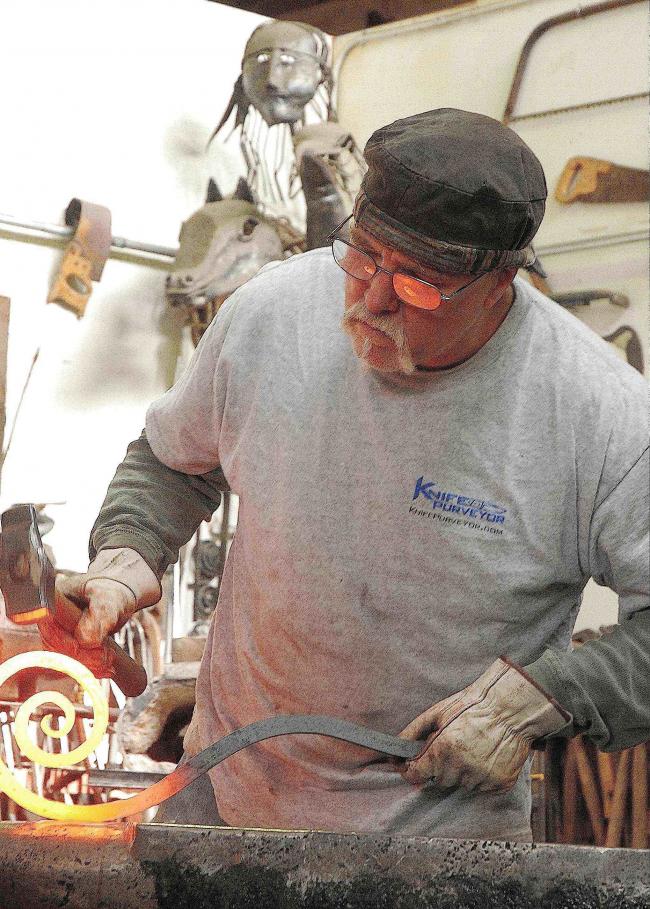Blacksmith, beekeeper forges ahead
Blacksmith, beekeeper and artist David Lisch lives and works in West Seattle.
Thu, 10/08/2009
David Lisch has many irons in the fire. In his 1,500 square-foot studio, Dragon Fly Forge, in the former Alaska Copper and Brass warehouse below the West Seattle Bridge just east of the Duwamish River, Lisch is a school teacher, expert knife maker, artist, interior/exterior designer and blacksmith.
In his Highland Park home he is a beekeeper. And, as his 50th birthday on Oct. 15, comes to pass, he is forging ahead with his poetry.
“I really feel that at 50 I am starting to reflect on my life,” said Lisch, who seems a curious combination of a tool-wielding tough and sensitive sculptor melded together.
“I have written poetry in different time periods of my life to mark time,” he said. He began his career in heavy metal as a fabricator at age 15.
His wife Andrea runs the power hammers, drills and helps with installs.
“She’s my right-hand man,” he said. “One anvil is my wife’s. One is mine.”
His studio is well organized with hundreds of tongs and hammers that, to the untrained eye may look redundant. Not so.
“Each set of tongs does something a little different,” he explained. “One might hold a half-inch metal piece, another five-eighths. The jaw has to close tight on different metal. I do have some duplicate tools because I teach blacksmithing here for a continuing education course for South Seattle Community College. I set up eight anvils for the students and we use two forges."
After two, four-hour sessions students go home with their own hand-made leaf hook, fire poker, and candle holder.
While Dragon Fly Forge is equipped with two large power 330 pound and 165 pound air hammers, it is the vintage 1920-era mechanical hammer he loves.
When operated, a big hunky bolt with extending arms and springs shimmy like a frenzied, dancing old man.
“Watch it pound,” he exclaimed. “It’ll crack you up. It rotates like an old sewing machine.”
Lisch said a large percent of his business is manufacturing textured metal for homes and business and creating displays for big companies like Nordstrom.
“A lot of people want warm textured metal in and around their house with a real old-world feel,” he said of his home remodeling and detailing. “Metal that has been in the fire, maybe made out of scrap, with exclusive materials like coppers, bronzes, stainless steel that have been forged and manipulated.
“When you walk through a residential gate I’ve made you might notice hinges textured with chamfered (beveled) edges, vines coming off, and forged leafs. Inside a home you might see my beam brackets held together with textured iron wrapped around beams with upsets, big square headed bolts, the fireplace hammered on with radiuses and curves, and great big hand irons in the fire, like you were going back in time.”
Lisch said 20 percent of his business comes from selling his hand-made knives. Like karate belts, knife makers have an official designation, beginning with apprentice, then jouneyman, then mastersmith. He said there are just three mastersmiths in Washington State.
One, Bob Kramer, put Lisch through the official American Bladesmith Society (ABS) test and he became a certified Journeyman last July. His sites are set for becoming certified a master soon. His journeyman test is featured on YouTube in fast motion.
His prize knife has a Damascus feather pattern with antique walrus tusk handle complete with a small hole in it as the tusk was once used as a fire starter. The price on that beauty is $1,600. Others are closer to $1,200.
Quality Damascus work is considered extremely difficult and is highly sought after.
Typical of a chat with Lisch, he may steer the conversation adroitly from red-hot steel to bees and honey.
“We got 60 jars of honey this year from our beehives at home," he said. " I learned about it from my grandfather. I am now learning how to keep bees over the winter.”
Thus at the flaming forge of life his fortunes must be wrought.


